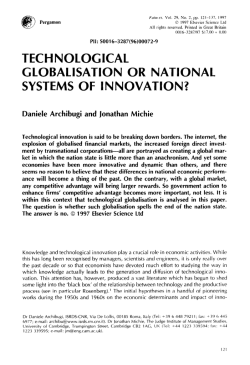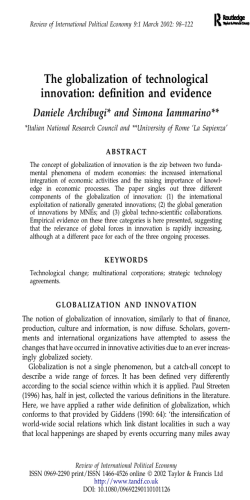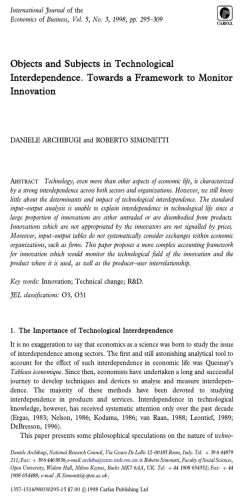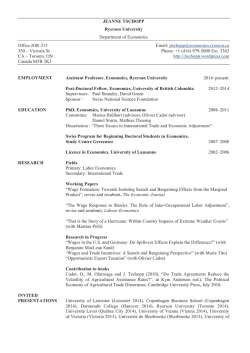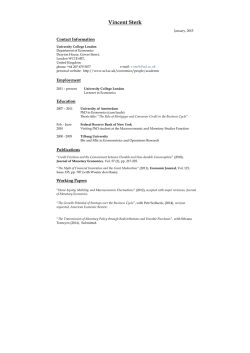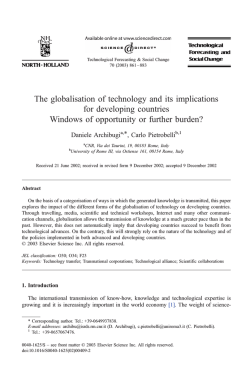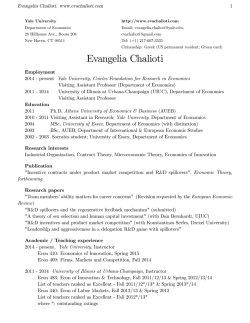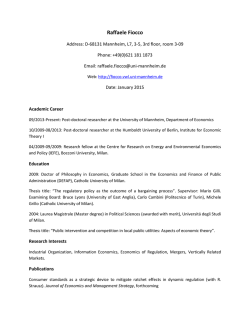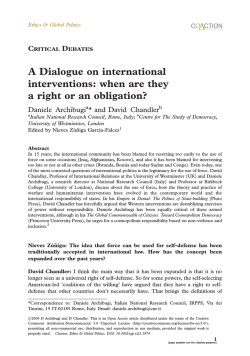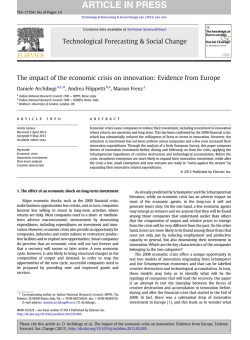
Download - Daniele Archibugi
TECHNICAL CHANGE, GROWTH AND TRADE: NEW DEPARTURES IN INSTITUTIONAL ECONOMICS Daniele Archibugil Institute for Studies on Scientific Research, Rome Jonathan Michie Birkbeck College, University of London Abstract. This article analyses the main theoretical and policy issues emerging from the literature on the evolutionary-institutional economics of technical change, the four distinguishing characteristics of which are that technology is often proprietary in nature; only a part of knowledge is codifiable in handbooks, blueprints, patents, and so on; there are fundamental variations in the above two points across different technological fields; and the evolution of knowledge is highly path-dependent. Keywords. Technology; Innovation; Trade; Growth; Globalisation; Policy 1. Introduction A survey of the main economic journals from the early 1950s to the late 1970s would show few articles on the theme of technical change. Moreover, the studies that were published were mainly concerned with the impact of technical change on variables such as growth, productivity, employment, and competitiveness; much less attention was devoted to understanding the sources and determinants of the generation of innovations. Over the same period the global economy experienced its Golden Age, involving the massive and systematic exploitation of scientific discoveries and technological innovation. But, despite a few noteworthy exceptions, economists were unable to understand — or possibly just uninterested in — its sources. Hence Joan Robinson’s remark that economists still treated technology as if it were provided by God and the engineers. Over the last two decades, economists have to some extent addressed this gap. Articles on technical change are published frequently in mainstream journals and new specialised ones have been established. New data sources have been created and conferences on this issue are held with increasing frequency. Even politicians, who have long preferred to rely on the advice of natural scientists and engineers, have allowed the advice of economists to inform their science and technology policies. While it was largely heterodox economists — Marxist, 0950–0804/98/00 0000–00 JOURNAL OF ECONOMIC SURVEYS Vol. 12, No. 3 © Blackwell Publishers Ltd. 1998, 108 Cowley Rd., Oxford OX4 1JF, UK and 350 Main St., Malden, MA 02148, USA. 2 ARCHIBUGI AND MICHIE Schumpeterian, evolutionary, or institutional — who first analysed technical change, orthodox economists have also increasingly turned to the study of the determinants of innovation, as testified by the emergence of the ‘new’ growth theory and ‘new’ trade theory. The literature on the economics of technical change has grown at a geometric rate over the past years. 1 A comprehensive reading list would need to combine the huge number of references cited in each of the recent handbooks by Dodgson and Rothwell (1994), Stoneman (1995), and Freeman and Soete (1997), plus a variety of other surveys. In spite of this renewed interest, our knowledge of the determinants of innovation and its impact on the economy is still limited. This is due not to a lack of interest, but rather to the multifarious nature of technology. Technological change is related to a wide range of other economic and social factors, with inventive and innovative activities involving a variety of phenomena which are difficult to conceptualise and measure in simple models. The economic studies on technical change fall largely into two schools. The first, neoclassical, school has discovered technical change only recently and its main focus has been the relationship between innovation on the one hand and growth and trade on the other. (For a review of new growth and new trade theories, see the surveys, respectively of Verspagen, 1992, and Krugman, 1995). The other school is more eclectic and has its milestones in the writings of Adam Smith, Friedrich List, Karl Marx, and Joseph Schumpeter and which has been reinvigorated in recent times by the writings of Nicholas Kaldor, Arthur Lewis and Albert Hirschmann. Chris Freeman, Richard Nelson, Nathan Rosenberg and their followers have explored in depth the implications of this approach for understanding technical change. Authors like Zvi Griliches, Edwin Mansfield, Mike Scherer and David Audretsch in the United States and Keith Pavitt, Luc Soete, Stan Metcalfe, Bengt-Ake Lundvall and Giovanni Dosi in Europe have addressed new questions drawing on — and themselves generating — a wealth of new empirical research. This broad literature has been characterised by an openness to inputs from related disciplines. It has drawn from historians such as Moses Abramovitz, Alexander Gerschenkron, and David Landes; from students of the firm such as Alfred Chandler, John Dunning, and Edith Penrose; and has often been inspired by social theorists like Derek de Solla Price, Michael Polanyi, and Thomas Kuhn. Although this literature has often been labelled ‘evolutionary’, the term ‘institutional’ may be more appropriate given the nature and variety of the contributions, which this body of work now incorporates. When addressing issues of growth and trade, neoclassical and institutional economists tend not to highlight their disagreements, preferring instead to ignore each other. Stoneman (1995) brings together survey-chapters by leading authors from both schools; however, each chapter is still mainly focussed on the literature from only one or the other of the approaches. Likewise this article will discuss recent research on the impact of technical change on growth and trade from the institutional school. This institutional school was analysing innovation ©BlackwellPublishersLtd.1998 TECHNICAL CHANGE, GROWTH AND TRADE 3 as a fundamental engine of growth and trade long before this became a fashionable topic within mainstream economics. This research within the institutional school is flourishing today more than ever, providing useful pointers both for understanding these real world processes and for informing policy making. 2. The links between technical change, growth, and trade The interconnections between technology on the one hand and the two major phenomena of economic growth and international trade on the other are clearly strong but at the same time rather complex. Historically, the dramatic rate of scientific and technical progress has taken place alongside two other epochmaking phenomena: economic growth, and social and economic globalisation. Indeed, technological progress, growth, and globalisation describe the three most significant aspects of the long-term evolution of the world capitalist economy. These complex phenomena are obviously interrelated, although this does not mean that the linkages can be easily specified. On the contrary, the complex relationships between technical change, growth and trade are still subject to debate and controversy despite the large body of theoretical and empirical research, which does exist. 2 The institutional literature in this field tends to combine theoretical discussion with empirical research. This is no accident: the processes of trade, growth and technical change need to be documented using quantitative evidence. Theoretical models alone are insufficient; they need to be confronted with just such historical and empirical documentation. The deductive method in economics has major limitations when not nurtured by observation of economic and social life. Some of the best economic theory in this field has indeed emerged from the exploration of the industrial world. There is another, although less explicit, element which unifies much of this literature, namely a clear policy relevance, with an implicit and sometimes explicit interest in understanding the devices which can be used to foster technical change. Market forces alone are seen to be far from adequate for the efficient generation, transfer, and diffusion of innovation. Governments have various fundamental and non-replaceable roles in the process of promoting technical change which can take various forms: firstly, the direct pursuit of scientific and technological activities, as in the case of universities and other publicly funded research institutions; secondly, the financial support of innovation carried out in the business sector; and thirdly, the supply of the necessary productive infrastructures, including education and training, standards and norms, and a legal system of intellectual property rights, to allow individuals and firms to innovate. 3 This article analyses the main theoretical and policy issues emerging from the institutional literature. 4 The next section highlights the main features of the key concept of technology. Sections 4, 5 and 6 discuss the relationship between ©BlackwellPublishersLtd.1998 4 ARCHIBUGI AND MICHIE technology and growth, while sections 7, 8 and 9 are devoted to the relationship between technology and trade. 3. The nature of technology Technology is a multifarious human activity. Its variety makes it difficult to capture in aggregate concepts and measures such as those used in macroeconomic modelling. To understand changes in technology it is necessary to pay attention precisely to this diversity. What might be described broadly as institutional theory has made several attempts to identify the key aspects underlying the very complex process of technological innovation. The central conclusion might be summarised within the following four points. The first is that technology is often proprietary in nature (Nelson, 1962, 1992). Mainstream economics has tended to view technology as a public good, freely available to all economic agents, costly to generate but able to be assimilated with no or negligible cost. 5 The institutional approach rejects this assumption and argues that the producers of new knowledge have a variety of legal and economic methods for securing returns from their innovations. Certainly, would-be imitators can acquire technological competence but this is a costly, time consuming process so that there will inevitably be some uncertainty about whether the economic returns obtained will repay the costs of imitating the innovation (see Mansfield, 1985). Secondly, institutional theory points out that only a part of knowledge is codifiable inhandbooks, blueprints, patents, scientific articles, and so on. There is an equally important part of knowledge which is tacit and which can only be acquired by long processes of learning (Lundvall, 1996). In this framework, knowledge is specific to economic agents such as individuals, firms, industries, and nations (Howells and Michie, 1997). Although some parts of know-how can be easily transferred from the producers to the users, this cannot be assumed to be a generalizable assumption. 6 Thirdly, there are fundamental variations across different technological fields. While technological innovation in some fields may be relatively easily accessible to many agents, the expertise needed to have access to technological innovation in other fields will be confined to rather restricted groups of experts. Each technology system (semiconductors, antibiotics, and so on), industry, and country has a specific regime of technological appropriation which makes the innovations either more freely available or else more proprietary in nature (Levin et al., 1987). Fourthly, the evolution of knowledge is highly path-dependent, that is, it is influenced by the knowledge already accumulated by economic agents in the past (Pavitt, 1988). 7 Although some agents might jump from one mix of competences to another, in the majority of cases, changes are rooted in the competences already acquired in the past (Nelson and Winter, 1977; David, 1985). Such a conception of technology has important implications for understanding the links between technical change, growth and trade. The following sections are devoted to highlighting some of these implications. ©BlackwellPublishersLtd.1998 TECHNICAL CHANGE, GROWTH AND TRADE 5 4. The engine of economic growth Technical change is one of the most important sources of long-term economic growth. New processes allow an increase in output per unit of input while new products create new markets and provide scope for output growth. Classical, neoclassical, Keynesian, and Schumpeterian economists alike would accept this assertion of the key role which technical change plays in fostering economic growth. But, although the causal link between technical change on the one hand and growth on the other is uncontroversial, a large number of often competing theoretical and empirical methods have been used to try to account for this influence of technological innovation on economic growth. In the late 1950s, the seminal papers by Abramovitz (1956) and Solow (1957) attempted to account for economic growth in the United States, finding it to be not fully explained by the increase in productive inputs such as labour and capital alone. The largest part of growth was thus attributed to a residual that, probably for lack of a more appropriate term, was labelled ‘technical change’. Already in 1956, Abramovitz noted that: ‘since we know little about the causes of productivity increase, the indicated importance of this element may be taken to be some sort of measure of our ignorance about the causes of economic growth in the United States and some sort of indication of where we need to concentrate our attention’ (Abramovitz, 1956, p. 133). 8 In subsequent research, much effort was devoted to trying to understand better the origin of productivity increases by ‘squeezing down’ the residual (Nelson, 1981), either by introducing other variables such as education, R&D, and other technology-related factors (on which, see the review by Griliches, 1995), or by adjusting to account for the different quality of inputs (on which see the review by Jorgenson, 1996). Several studies undertook such growth accounting for a variety of countries, allowing international comparisons to be made (see Denison, 1967). These showed clearly that growth rates varied considerably across nations and that differences in technological competence played a significant role (see also Abromovitz, 1989). Although this body of literature enlarged the original framework, technology was still treated as a public good. 9 The basic prediction of the neoclassical theory, 10 based on the notion that the main engine of growth — technology — was a freely available good, was that in the long run all countries should converge towards a similar income level (providing that they were experiencing the same rates of capital accumulation). This hypothesis emerged basically from the actual economic trends of the postWorld War Two period with the United States having a large technological advantage over rival countries and transferring know-how and expertise to several allied countries (see Rosenberg, 1972; Nelson and Wright, 1992). This was a crucial factor in helping some of these countries — most notably Japan, Germany, and Italy — achieve growth rates higher than the US itself (the leading country). However even during the 1950s and 1960s the assumption of freely available and transferable technological know-how was unrealistic, with many countries failing to benefit substantially from such know-how produced by the ©BlackwellPublishersLtd.1998 6 ARCHIBUGI AND MICHIE leading country. Growth theory was thus unable to explain why some countries managed to catch up while others fell behind. 5. New departures on growth and technology Different hypotheses on economic development emerged from a variety of sources. Although the view remains that a substantial income gap offers an opportunity for catching up, this is no longer credited to free access to the available stock of knowledge. It has been pointed out that emerging countries might avoid repeating the same mistakes and learn at a faster pace than their predecessors (Ames and Rosenberg, 1963). These countries might also benefit from new vintage capital stock and from being able to create a more modern infrastructure than their predecessors would have been able to at a similar stage of development. However, the broadly institutional theory suggested strongly that such catching up in income is neither automatic nor easy to accomplish. Institutional factors, such as social rigidity (Gerschenkron, 1962), a stratified class structure (Olson, 1982), or an unwillingness to provide incentives for the innovators (Rosenberg and Birdzell, 1986) can seriously hamper the catching up potential of a nation. These arguments were supported by a large body of evidence, more of a historical thanan econometric nature. In the nineteenth century, Germany had managed to catch up in industrial development in part by successfully exploiting and learning from British technology but at the same time Russia had failed, in part due to her failure to have broken with the feudal structure of Russia’s countryside. In the second half of the 20th century, Japan managed to catch up with the United States, while other countries did not. And over the last twenty five years in particular, several countries in the East Asian rim managed to take off in industrial development while countries which in the early 1970s appeared to have certain advantages, such as the Latin American nations, failed to so develop. The history of economic development thus shows that growth patterns tend to be related to specific economic, institutional, social, and cultural differences across countries. Generalising from these lessons, it would seem that to close a gap in income, technologically lagging nations need to catch up in terms of technological competence. Indeed, there appear to be no examples of a country catching up in terms of technology without also catching up in terms of income. Of course, this leaves open the question of causality. Technological competence may be the thermometer of economic development as much as its engine (Dosi, 1982), yet the evidence appears to support the view that technological competence is the key to a successful catching up strategy. A successful strategy for economic development will therefore be associated with the ability of the country in question to create its own endogenous expertise. The competence level of nations is highly varied — as indicated by a variety of internationally comparable data on education, labour productivity, the generation of innovations, and so on. How important are these technology gaps for ©BlackwellPublishersLtd.1998 TECHNICAL CHANGE, GROWTH AND TRADE 7 predicting countries’ growth rates? Within the traditional neoclassical framework, the existence of such gaps is not denied, but they are not considered to be very important in the long run. Non-neoclassical theory, on the other hand, would regard such technology gaps as important determinants of growth rates since the ability to exploit knowledge developed elsewhere will be heavily conditioned by the starting position of each nation. Institutional theory would also hold that the various components of technological competence can play very different roles in development. Education, formal activities devoted to generate innovations, expertise in the capital good sectors, high levels of international integration, and so on, are all considered to be potentially important factors in nurturing economic development. But of course, each of these factors can play a different role depending on the nature of the technologies, industries, and countries involved. Gittleman and Wolff (1997), analysing a large number of developed and developing countries, argue that within the restricted club of the industrial market economies, investment in formal R&D activities appears to be related to growth rates but that it does not play any significant role in explaining growth rate differences among developing countries. 11 Education and training play much more important roles in allowing such countries to achieve high growth rates. This result is intuitively plausible: countries at the initial stage of their industrial development might benefit much more by substantial training and education programmes since this will allow them to absorb a vast and still unexploited global stock of knowledge. Investing their own resources to produce original knowledge is certainly beneficial in the long run, but it will require major investments to reach the critical mass needed to secure economic returns. Moreover, formal knowledge needs to be combined with other assets such as an adequate capital stock, a productive infrastructure, and so on, which may be lacking in underdeveloped countries. But after a certain degree of economic development, the strategy of acquiring know-how from abroad without any endogenous effort will become much less effective. Imitative activities become much closer to innovative activities and countries that fail to couple imitation with innovation jeopardise their long-term economic performance. Concentrating on the more homogeneous and integrated group of the OECD economies, Pianta (1997) shows that the growth paths followed by these nations was nurtured from different sources. For some countries the crucial source of growth has been intangible investment proxied by R&D expenditure, while other countries have concentrated on gross fixed capital formation. Both R&D and investment are crucial engines for development, although each country has a distinctive balance between the two. Significantly, countries with the highest growth rates have typically combined their efforts in tangible and intangible investments. Patel and Pavitt (1997) and Archibugi and Pianta (1997) address the issue of convergence from the viewpoint of resources devoted by nations to technological expertise. Focusing on industrial countries only, these studies show that patterns of convergence in the generation of technology (measured by R&D and patentbased indicators) do not emerge strongly, and that in some cases a divergent pattern has occurred over the last twenty years. The same countries have ©BlackwellPublishersLtd.1998 8 ARCHIBUGI AND MICHIE experienced a limited but significant convergence in GDP per capita. These asymmetric trends between technological and economic indicators need to be explained. It could be argued that the laggard industrial countries within this group managed to catch up in income by acquiring the technology of the leading countries. A number of sources, such as increased trade flows, foreign direct investment, formal cooperation agreements, and so on, might have helped this process. The basic question is how far such a convergence in income could go without a similar convergence in technology. The answer to this depends in part on where technological capabilities reside: the nation-state, the business firm, or elsewhere. 12 The view that technological capabilities reside in the nation state has been articulated in the ‘national systems of innovation’ literature discussed in Section 9 below, in which firms are seen as embedded in a larger national institutional and cultural system that includes universities, financial institutions and labour markets, bodies of law that mould and constrain what firms can do, government policies that support technological advance and assist national business firms, and other features that draw a divide between what is inside and what is outside a particular nation state. The view that firms themselves are the locus of technological capabilities focuses on the intertwining of technology with organisation and management, on the tacit nature of many important capabilities, and on organisational learning and history as the key factors determining what a firm can to at any time. Other theories focus on entities larger than the firm but smaller than the nation state, as with the resuscitation of Marshall’s industrial district idea under which it is, say, Silicon Valley rather than the US on the one hand, or individual firms within Silicon Valley on the other, which is key to an understanding of innovation. 6. Beyond aggregate growth models The studies of Patel and Pavitt (1997) and Archibugi and Pianta (1997) also make clear that an analysis of technological convergence at the aggregate level is highly unsatisfactory. As outlined in section 3 above, technology is a highly diversified phenomenon. Each country has a specific pattern of technological advantages in some areas and disadvantages in others. Moreover, competence in different technological areas will not have the same impact on growth. Traditional growth theory implicitly assumes that the level of efficiency reached by each country is more important than the choice of its main products: ‘what to produce’ is less important than ‘how to produce’. On the contrary, institutional theory stresses that the sectoral composition of output, as well as of technological competence, is a key factor in determining growth rates. In Freeman’s words: ‘Economic growth is not merely accompanied by fast-growing new industries and the expansion of such industries; it primarily depends on that expansion’ (Freeman, 1994, p. 79). Countries that invest their resources in new and expanding industries have, ceteris paribus, a better chance of growing than do countries that invest in declining industries. Already in the early 1960s, the technology gap theory emphasised the crucial ©BlackwellPublishersLtd.1998 TECHNICAL CHANGE, GROWTH AND TRADE 9 importance of sectoral, rather than aggregate, competence differences across countries in explaining economic performance (see Posner, 1961). 13 Thus while the technological lead of a nation in some areas is being eroded by the imitation of other nations, new divergences between the leader and the followers may occur in other rising industries. Posner and his followers assumed, however, that the world’s technological capabilities were organised according to a precise hierarchy and that the leading country would have preserved its leadership. Although the gap would have necessarily shifted from one industry to another (from aircraft to semiconductors, from semiconductors to biotechnology, and so on), it was assumed that the leader would have continued to lead, and the followers to follow. This is not surprising if we consider that this hypothesis was formulated at the beginning of the 1960s when one country, the United States, had a clear lead in most high technology products. But this model is no longer a valid characterisation of the contemporary world. On the one hand, the number of countries at the frontier of technological innovation has grown considerably, while on the other hand the knowledge base of contemporary society has experienced an impressive expansion. The division of labour between countries now takes place in both new and traditional industries. Patel and Pavitt (1997), elaborating on (while in a sense departing from) the notion of technology gaps, identify the advantages and disadvantages of nations across the various technological fields, finding a rather different technological landscape, where each nation has a distinctive and not necessarily hierarchical place in the world’s division of labour. While Japan is still lagging behind in nuclear technology vis-Ða-vis the United States, the United States is now lagging behind Japan in photography and several other industries. This has been systematically measured by looking at the sectoral strengths and weaknesses in scientific and technological activities (see Archibugi and Pianta, 1992), and by looking at the technological strengths of national large firms in a number of patent classes (see Patel and Pavitt, 1997). It is certainly significant that the differences in the technological profiles of countries are increasing, as shown by Archibugi and Pianta (1997). This has important implications for the debate on convergence and catching up. Although a partial convergence in efforts to generate and assimilate innovations is occurring among a restricted club of countries, this does not mean that countries are converging towards a similar profile of sectoral specialisation. It rather seems that convergence in the aggregate amount of resources devoted to innovation is coupled with an increased division of labour in the generation of new technologies. 7. High technology and specialising for growth Moving away from standard aggregate macroeconomic models, a sectoral analysis of nations’ innovative activities has some important implications for growth theories. As already argued, the growth rate achieved by a country is not only related to the aggregate amount of resources devoted to innovation. This is ©BlackwellPublishersLtd.1998 10 ARCHIBUGI AND MICHIE surely a fundamental part of the story, but it is equally important to look at the sectoral composition of these efforts. It can no doubt be readily accepted that countries which concentrate their resources in the new and growing technological fields will have, other conditions being equal, a higher probability of growing faster; the question is, which are these fields? It is generally assumed that the so-called ‘high-tech’ industries serve nations’ competitive performance best. World trade in high-tech industries, and especially in the high tech electronic products, has grown much more than in other manufacturing industries (see Table 1 in Guerrieri and Milana, 1997). This evidence corroborates the general view that high technology means high growth. However, the definition and meaning of ‘high-tech’ industries is not unproblematic. Grupp and Munt (1997) argue that the concept of high technology is not well defined in economics, proposing a more accurate distinction between ‘leading-edge’ and ‘high-level’ technologies. Guerrieri and Milana (1997) challenge the standard measures based on R&D-intensity of industries and propose a more complex approach based on expert judgements. Despite some pioneering studies, 14 however, we know little about the role played by crucial bandwagon sectors in industrial development. Economic historians have shown the importance of emerging industries for development; we generally associate the industrial revolution with steam engines, textile machinery and railways, and the public opinion of our age rightly associates the contemporary economic transformations with computers, software, and telecommunications. But economic theory is still lagging behind: while interesting industry case-studies are available, and sophisticated multi-sectoral growth models have been developed, a systematic exploration of the role played by rising sectors in economic growth is still lacking. It is to be hoped that research on innovation and development will fill this gap over the next few years. 8. Innovation and international competitiveness It has long been a subject of debate whether, in the classical example of comparative advantage (Portuguese wine and English cloth) David Ricardo was implying more importance to nations’ resource endowments or to nations’ technological competence. Whatever Ricardo’s thoughts on the matter, for too long international economics paid too much attention to resource endowments and too little to technological competence (see Krugman, 1995). In the last decade, the situation has changed, as indicated by the growing technology-gap trade theory and, more recently, by the new growth theory. It is now generally accepted that advantages in technological competence will lead to a better performance in foreign trade (see for example Hughes, 1986). There are at least three links between innovation and international competitiveness. First, process innovations reduce production costs and hence output prices, increasing competitiveness. Secondly, minor product innovations improve the quality of commodities and make them more appealing in both domestic and foreign markets. Thirdly, major product innovations create, for a limited period ©BlackwellPublishersLtd.1998 TECHNICAL CHANGE, GROWTH AND TRADE 11 of time, a monopolistic position that helps to impose those products in the market, while at the same time bringing in monopoly profits. As argued above, the technology-gap trade theory has since the early 1960s (Posner, 1961) stressed the crucial role of innovation as a determinant of export market shares. This hypothesis is tested by Amendola, Guerrieri and Padoan (1997) who use a detailed database which combines trade and patent data for 10 industrial countries and 38 industries to show that the differences between countries in terms of trade specialisation are larger than in terms of technological specialisation, reinforcing the view that advanced industrial economies require a wide technological base. Research also shows that the division of labour among countries, at least in manufacturing, evolves slowly, corroborating the hypothesis of a cumulative pattern of technological competence. From a nation’s perspective, it is certainly much more difficult than predicted by Posner to move from an established competitive advantage in one industry to another. As suggested by Nelson and Winter (1977) and Pavitt (1988), expertise moves along ‘natural’ trajectories of technological accumulation. A country leading in the chemical industry will probably have an advantage over other nations in entering new and related fields such as new synthetic materials, but it is much more difficult for a leading country in aircraft or nuclear technologies to exploit these advantages in, say, consumer electronics. Inasmuch as technological competence is concerned, sector-specific accumulation prevails over leap frogging. 15 The third and most significant result of Amendola, Guerrieri and Padoan’s research is that technological innovation is a crucial factor in explaining trade patterns at the sectoral level. Countries manage to perform well in international trade in the sectors where they also excel in terms of technological innovation. The comprehensive time-period covered provides a solid test of the role of technology in international competitiveness. It is, however, important to note that this exercise moves away from the traditional technology gap approach, since it no longer assumes the existence of an established hierarchy among nations. Looking at the comparative, rather than absolute advantages, the authors show that the eleven nations considered in the test have a mixed pattern of specialisation in both new and traditional technologies. It is certainly significant that the United States has trade and technology advantages in resource-based as well as technology-intensive industries. What are the implications of this empirical evidence? One implication should be to allow us to understand the advantages to be had for any one country from innovating to a greater extent than its competitors, and over a wider range of industries. In the short term, these benefits will translate into a surplus in the trade balance. In the longer term, innovative nations will have two main advantages: firstly, improved terms of trade, and secondly, the ability to specialise in whatever proves to be the most rewarding industries. Both of these could prove crucial factors in allowing a nation to achieve higher growth rates. Grupp and Munt (1997) also show that the sources of competitive trade advantage are substantially different for the two groups of leading edge and high-level technologies. While leading-edge technologies rely mainly on scientific inputs ©BlackwellPublishersLtd.1998 12 ARCHIBUGI AND MICHIE and involve heavy interactions between public and business R&D, high-level technologies are much more dependent on firms’ decisions to invest in innovation. Empirical tests for the European countries show that a strong division of labour has occurred within the region, with Germany and the Netherlands focusing on high-level technologies and France and the United Kingdom on leading-edge technologies. It is well known that globalisation implies much more than international trade. 16 Firms can use a variety of methods to exploit their innovations, which include foreign direct investment, non-equity collaborations, granting of licences, and so on. We are well aware of these aspects although they are not addressed directly in this article (but on which see Archibugi and Michie, 1995). New and more complex forms of internationalisation, however, have not reduced the crucial importance of trade. International competitiveness shaped by innovation remains one of the fundamental determinants of nations’ comparative performance and the pursuit of such competitiveness has been crucial to public policy. 9. National systems and the importance of the domestic market Given that countries’ specialisation in trade and technology matters for their growth rates, what are the determinants of a country’s position within the international division of labour? Following the suggestions of Kaldor and Linder, Fagerberg (1995) argues that the domestic market can play a crucial role in fostering a nation’s ability to excel in certain products rather than in others. 17 The role of ‘advanced domestic users’ has been emphasised by Porter (1990), while Pavitt (1984) and von Hippel (1988) have argued convincingly that users can play a crucial role in promoting innovation, and this often takes place in systems of innovation which are national in scope (Lundvall, 1992; Nelson, 1993; Freeman, 1995). The importance of the domestic market is tested by Fagerberg for a sample of 16 advanced countries and 23 different product groups in three different years (1965, 1973, and 1987). The sample considers the export performance of mainly intermediate products and links them to the expected main users in the domestic market (see Fagerberg, 1995, Table 1). This implies that the linkages explored are of a vertical nature (such as textile machinery-textiles; tractors-agricultural products, and so on). Fagerberg’s results confirm that the domestic market plays an important role in fostering international competitiveness. He also shows that nations open to foreign trade exploit their own domestic user-producer linkages better. Given that the domestic market is an important stimulus to achieving international competitiveness, targeted industrial policies can thereby boost a country’s trade position and hence growth rates. The importance of nation-specific factors in developing technological innovation has been stressed by the ‘national systems of innovation’ literature referred to above. Freeman (1987) introduced the concept to describe and interpret the performance of Japan, and it has since been applied to several other ©BlackwellPublishersLtd.1998 TECHNICAL CHANGE, GROWTH AND TRADE 13 countries and to different areas (see, for example, the chapters by Freeman, Lundvall, and Nelson in Dosi et al., 1988). Lundvall (1992) investigated the roles played in the innovation process by users, the public sector, and financial institutions within nation states, while Nelson (1993) assembled a number of case-studies to describe the main features of the innovation systems of high, medium, and low income countries. More recently the OECD has taken up the idea of national systems of innovation and is attempting to operationalise it through the collection and analysis of indicators, focusing in particular on the financial dimension, the interconnections among the various institutions, and the distribution of knowledge across national agents. Although the concept of national systems of innovation is defined and applied differently (on which see McKelvey, 1991), the various authors share the view that nation-specific factors play a crucial role in shaping technological change. Some of these factors are institutional, such as education, public support to industrial innovation, and defence-related technology schemes. Others are rooted in history, and concern the country’s culture, size, language and so on. Crucial to the definition of a national system is how the different parts, such as universities, research centres, business firms, and so on, interact with each other. 10. Conclusion: new departures Fresh exploration is called for, of the connections between three epoch-making phenomena: technical change, growth, and trade. The generation and impact of innovations, the factors that rule economic growth and their differences between countries, and the role of trade in the organisation of the world economy, are all issues deserving further analysis. Such work can best be done by exploring the interdependence between these phenomena. Three key areas that, we would argue, require further research are as follows: 10.1. Complexity: inside the black box Although the importance of technology has become widely recognised by mainstream economics, as indicated by the new growth and new trade theories, insufficient attention has so far been devoted to accounting for its complexity. To do so requires empirically testable questions rather than abstract models; these can certainly be formulated and the results to date, even when rough, do tell us something about the nature of innovation, which is an indispensable component for the construction of a theory of economic growth. Studies of the way in which knowledge actually leads to the generation and diffusion of technological innovation have produced a vast literature which has begun to shine some light into the ‘black box’ of the relationship between technology and the productive process (e.g. Rosenberg, 1976, 1982, 1994). Innovation is found to be far more than just a series of isolated events shaped by enlightened inventors, forwardlooking entrepreneurs, or dynamic corporations. Certainly, individuals and firms play a crucial role in the development of specific innovations, but the process ©BlackwellPublishersLtd.1998 14 ARCHIBUGI AND MICHIE which nurtures and disseminates technological change involves a complex web of interactions among a range of different subjects and institutions (David and Foray, 1995; Smith, 1995). 10.2. Level of aggregation The main patterns and regularities that emerge from complexity can be discerned with the help of detailed case studies and quantitative economic studies. We have already pointed out that there is a significant difference in the two literatures on innovation/growth and innovation/trade. Much of the innovation/growth literature is at the aggregate level only, ignoring the crucial importance played by sectoral differences. Much of the innovation/trade literature is on the contrary at the industry level, although it often overlooks the macroeconomic implications. We believe that some ‘spill-overs’ might be beneficial to both these bodies of literature. The influence of technology on growth will become much clearer once it is accepted that not all knowledge has the same impact on economic performance. Likewise, studies of technological competence and trade should devote more attention to the macroeconomic and long-term implications. 10.3. Policy Growth and competitiveness are two areas of major policy concern. The advancement of knowledge is also an area of active policy action, particularly because of its feedback effects on economic performance. Too often, however, economic research in this field fail to focus on any clear policy questions, hampering the impact of such studies. The economics of innovation, trade, and growth can only benefit from a clearer focus on policy options and questions. This requires theorising grounded in economic, social, and institutional realities that will not only increase the usefulness of such work but may also sharpen the focus. The work we have discussed in this article — which includes an encouraging number of recent additions to the literature — represents, we believe, an important step in this direction, with theoretical discussion grounded in just such an approach, a wealth of new empirical research, and clear policy discussion pointing not only to the importance of achieving an innovative economy but pointing also to the sort of public policy initiatives which would help to achieve such goals. Taken together, this body of literature identifies the following aspects as being crucial for policy. First, education and training: in spite of the international diffusion of education and of the increasing, although still limited, number of students enrolled in foreign universities, education is still largely national in scope. Not only are there substantial differences among countries in the proportion of any given age group actually participating in education, the distribution of students by disciplines also varies markedly among countries (on which see for example Mower and Oxeye, 1995). ©BlackwellPublishersLtd.1998 TECHNICAL CHANGE, GROWTH AND TRADE 15 Secondly, the level of resources devoted by different countries to formal R&D and other innovation-related activities (such as design, engineering, tooling-up, and so on) differs significantly with a small group including the US, Japan, Germany, Switzerland, and Sweden devoting around three per cent of their GDP to formal R&D activities, with other countries spending far smaller proportions of their GDP in this way. Another important difference relates to how R&D expenditure splits between the public and business sectors; big government programmes in space, defence and nuclear technologies often shape the entire structure of a nation’s science and technology (S&T) system. Thirdly, the industrial structure of a country will condition the nature of its innovative activities given the role of firms as the principal agents of technological innovation. Thus, for example, large firms are more likely to undertake basic research programmes and are also more likely to be able to afford long-term investment in innovative activities -- whose payback may not only be spread years into the future but may also be extremely uncertain. The level of competition faced by companies in their domestic mark et al so plays a crucial role in the R&D investment outcome. Government approaches to competition policy as well as to industrial policy, and to creating institutions to foster productive cooperation, can therefore impact on the innovative activities of firms (on which, see Kitson and Michie, 1998). Fourthly, interactions within the innovation system: the propensity of the different institutions to co-ordinate their activities and to interact with other actors differs widely among countries. In general, though, governments do interact heavily with large domestic firms (the so-called ‘national champions’). Fransman (1995) discusses the Japanese Ministry for International Trade and Industry (MITI), generally seen as a successful institution for the promotion of innovation in industry. In other countries, small firms have been keen to share their expertise and co-operate in developing a common competitive strategy, as demonstrated by the Italian industrial districts. Such interactions are often able to multiply the effects of innovation undertaken at the country level and increase its diffusion, and conversely their absence can hamper the economic effectiveness of resources devoted to S&T; (see Kitson and Michie, 1998, for evidence on such cooperation and innovation amongst UK Small and Medium Sized Enterprises). Finally, the operation of these various aspects of national systems of innovation needs to be considered within the context of increasing international integration. For technology transfer to be effective requires an endogenous effort to acquire and apply that knowledge; see Bell and Pavitt (1997), Freeman (1995), and Mowery and Oxley (1995). Acknowledgements We are grateful for helpful suggestions from Rinaldo Evangelista, Sarah-Kay McDonald, Mario Pianta, Giorgio Sirilli, Paz Estrella Tolentino and two anonymous referees of this Journal. ©BlackwellPublishersLtd.1998 16 ARCHIBUGI AND MICHIE Notes 1. Freeman (1997) provides a state of the art overview of the economics of technical change focussing especially on the latest developments. 2. On the separate issue of the direct relationship between growth and trade, see Kitson and Michie (1995). 3. For surveys of the economic theory of technology policy, see Metcalfe (199Sa; 1995b), Mowery (1995), and Dasgupta and Stoneman (1987). 4. The various contributions to the literature which we have chosen to focus upon below inevitably represent only a selective sample; for related research on the themes of technical change, growth, and trade following broadly the same approach taken in this article see especially Dosi (1988); Dosi, Pavitt and Soete (1990); Fagerberg, Verspagen and von Tunzelmann (1994); Kennedy and Thirlwall (1973); and Silverberg and Soete (1994). 5. Although Arrow (1962) is responsible for this mainstream formulation, he has been much more open minded in questioning this assumption than many of his followers. See, for example, Arrow (1994). New growth theory has dropped the hypothesis that knowledge is a freely available good (see Grossman and Helpman, 1991), but other recent growth literature still regards technology as freely accessible. For a critical review of this literature, see Verspagen (1993). 6. For a survey of the economics, management, and industrial sociology literature on firms and organisations, which discusses the role of information and knowledge, see Buckley and Michie (1996). 7. Rosenberg (1976) made a major contribution to the notions of path dependency and other characteristics of technology. 8. That this statement was an accurate representation of the point of departure in the field is indicated by the fact that it is probably the single most cited phrase in the economics of growth. 9. For a comprehensive review of the literature on growth rate differentials, see Fagerberg (1994). 10. On the treatment and role of innovation in neoclassical growth models, see Verspagen (1992). 11. Coe et al. (1997) examine the extent to which developing countries that do little R&D benefit from that performed in the industrialised countries and argue that by trading with an industrial country that has a large ‘stock of knowledge’ from its cumulative R&D activities, a developing country can boost its productivity; their results, based on data for 77 developing countries, suggest that R&D spillovers from 22 industrial countries over 1971 – 90 are substantial. 12. As discussed briefly by Nelson (1997) on which this paragraph draws. 13. The importance of an analysis at the sectoral level emerged especially in the technology-gap trade theory (see Soete, 1981; 1987). 14. Meliciani and Simonetti (1996) and Breschi and Mancusi (1996) develop a methodology to identify the fast growing and the declining technological classes, and has used this to indicate the comparative position of individual nations. 15. Cantwell (1989) has shown that patterns of technological accumulation tend to be stable across long historical periods. 16. For discussion of the process of globalisation and its implications for corporate strategy and economic policy see Hood and Wahlne (1988), and for a critique of much of the literature which, it is argued, exaggerates or otherwise misreads the process, see Michie, 1996. 17. McCombie and Thirlwall (1997) make a more general criticism of the continued dismissal of demand constraints as an explanation of inter-country growth rate differences in the new growth theory literature, and put forward an explicitly demandorientated model of economic growth. ©BlackwellPublishersLtd.1998 TECHNICAL CHANGE, GROWTH AND TRADE 17 References Abramovitz, M. (1956) Resource and output trends in the United States since 1870, American Economic Review, Papers and Proceedings, 46(2), 5–23 (reprinted in Abramovitz, M., 1989). Abramovitz, M. (1989) Thinking About Growth. Cambridge: Cambridge University Press. Amendola, G., Guerrieri, P. and Padoan, P.C., (1997) International patterns of technological accumulation and trade, in Archibugi, D. and Michie, J. (eds), 1997b. Ames, E. and Rosenberg, N. (1963) Changing technological leadership and industrial growth, Economic Journal, 73(March), 13–31. Antonelli, C. (1994) The Economics of Localized Technological Change and Industrial Dynamics. Boston: Kluwer Academic Publishers. Archibugi, D. (1997) The economics of innovation and technological change: two Handbooks and two masters, International Review of Applied Economics, 11(2)(May), 303 – 309. Archibugi, D. and Michie, J. (1995) The globalisation of technology: a new taxonomy, Cambridge Journal of Economics, 19(1)(February), 121–40; reprinted in Archibugi, D. and Michie, J. (eds) 1997a. Archibugi, D. and Michie, J. (eds) (1997a) Technology, Globalisation, and Economic Performance. Cambridge: Cambridge University Press. Archibugi, D. and Michie, J. (eds) (1997b) Technology, Trade, and Growth. Cambridge: Cambridge University Press. Archibugi, D. and Pianta, M. (1992) The Technological Specialization of Advanced Countries. Boston: Kluwer. Archibugi, D. and Pianta, M. (1997) Aggregate convergence and sectoral specialisation in innovation: evidence for industrial countries, in Archibugi, D. and Michie, J. (eds) 1997b. Arrow, K. (1962) Economic welfare and the allocation of resources for invention, 609 – 625 in Nelson, R. R. (ed.), The Rate and Direction of Inventive Activity. Princeton: Princeton University Press for the National Bureau of Economic Activity. Arrow, K. (1994) The production and distribution of knowledge, 9–19 in Silverberg, G. and Soete, L. (eds.), The Economics of Growth and Technical Change. Technologies, Nations, Agents. Aldershot: Edward Elgar. Bell, M. and Pavitt, K. (1997) Technological accumulation and industrial growth: contrasts between developed and developing countries, in Archibugi, D. and Michie, J. (eds) 1997a. Breschi, S. and Mancusi, M. L. (1996) Il modello di specializzazione tecnologica dell’Italia, in Quaderni di politica industriale n. 8, Mediocredito Centrale, Rome. Cantwell, J. (1989) Technological Innovation and Multinational Corporations. Oxford: Blackwell. Coe, D. T., Helpman, E. and Hoffmaister, A. W. (1997) North-South R&D Spillovers, Economic Journal, 107 (January), 134–149. Dasgupta, P. and Stoneman, P. (eds) (1987) Economic Policy and Technological Performance. Cambridge: Cambridge University Press. David, P. (1985) Clio and the economics of QWERTY, American Economic Review, Papers and Proceedings, 75, 332–337. David, P. and Foray, D. (1995) Accessing and expanding the science and technology knowledge base, Science Technology Industry Review, no. 16, 13–68. Denison, E. F. (1967) Why Growth Rates Differ: Post-War Experience in Nine Western Countries. Washington, D.C., Brookings Institution. Dodgson, M. and Rothwell, R. (eds) (1994) The Handbook of Industrial Innovation. Aldershot: Edward Elgar. Dosi, G. (1982) Technological paradigms and technological trajectories: a suggested ©BlackwellPublishersLtd.1998 18 ARCHIBUGI AND MICHIE interpretation of the determinants and directions of technical change, Research Policy, 11(3), pp. 147 – 162. Dosi, G. (1988) Sources, procedures and microeconomic effects of innovation, Journal of Economic Literature, 36, 126 –1171. Dosi, G., Freeman, C., Nelson, R., Silverberg, G. and Soete, L. (eds) (1988) Technical Change and Economic Theory. London: Pinter. Dosi, G., Pavitt, K. and Soete, L. (1990) The Economics of Technical Change and International Trade. Brighton: Wheatsheaf. Fagerberg, J., Verspagen, B. and von Tunzelmann, N. (eds) (1994) The Dynamics of Technology, Trade and Growth. Aldershot: Edward Elgar. Fagerberg, J. (1994) Technology and international differences in growth rates, Journal of Economic Literature, 32 (September), 1147–1175. Fagerberg, J. (1997) User-producer interaction, learning and comparative advantage, Cambridge Journal of Economics, 19(1), 243–56; reprinted in Archibugi, D. and Michie, J. (eds) 1997b. Fransman, M. (1995) Is national technology policy obsolete in a globalised world? The Japanese response, Cambridge Journal of Economics, Vol. 19, no. 1 (February), 95 – 119; reprinted in Archibugi, D. and Michie, J. (eds) 1997a. Freeman, C. (1987) Technology Policy and Economic Performance. London: Pinter. Freeman, C. (1994) Innovation and Growth, 78–93 in Dodgson, M. and Rothwell, R. (eds) 1994. The Handbook of Industrial Innovation. Aldershot: Edward Elgar. Freeman, C. (1995) The ‘national system of innovation’ in historical perspective, Cambridge Journal of Economics, 19(1)(February), 5–24; reprinted in Archibugi, D. and Michie, J. (eds) 1997a. Freeman, C. (1997) The economics of technical change, in Archibugi, D. and Michie, J. (eds) 1997b. Freeman, C. and Soete, L. (1997) The Economics of Industrial Innovation and Technical Change. London: Pinter Publishers. Gerschenkron, A. (1962) Economic Backwardness in Historical Perspective. Cambridge, Mass.: Belknap Press. Guerrieri, P. and Milana, C. (1997) Changes and trends in the world trade in hightechnology products, Cambridge Journal of Economics, 19(1), 225–242; reprinted in Archibugi, D. and Michie, J. (eds) 1997b. Gittleman, M. and Wolff, E. N. (1997) R&D activity and cross-country growth comparisons, Cambridge Journal of Economics, 19(1), 189–207; reprinted in Archibugi, D. and Michie, J. (eds) 1997b. Griliches, Z. (1995) R&D and productivity: econometric results and measurement issues, 52 – 89 in Stoneman, P. (ed.), Handbook of the Economics of Innovation and Technological Change. Oxford: Blackwell. Grupp, H. and Munt, G. (1997) Trade on high-technology markets and patent statistics: leading edge versus high level technology, in Archibugi, D. and Michie, J. (eds) 1997b. Grossman, G. and Helpman, E. (1991) Innovation and Growth in the Global Economy, Cambridge, Mass.: MIT Press. Hood, N. and Wahlne, J. E. (eds) (1988) Strategies in Global Competition. Beckenham: Croom Helm. Howells, J. and Michie, J. (eds) (1997) Technology, Innovation, and Competitiveness. Aldershot: Edward Elgar. Hughes, K. (1986) Technology and Exports. Cambridge: Cambridge University Press. Jorgenson, D. (1996) Endogenizing investment in tangible assets, education, and new technologies, paper presented at the seminar Finance, Research, Education, and Growth, University of Rome ‘Tor Vergata’, Rome, June. Kennedy, C. and Thirlwall, A.P. (1973) Technical progress, in Surveys of Applied Economics, vol. 1, London, Macmillan for the Royal Economic Society. ©BlackwellPublishersLtd.1998 TECHNICAL CHANGE, GROWTH AND TRADE 19 Kitson, M. and Michie, J. (1995) Conflict, Cooperation and Change: the political economy of trade and trade policy, Review of International Political Economy, Volume 2(4) (Autumn), 632 – 657. Kitson, M. and Michie, J. (1998) Markets, competition, and innovation, in J. Michie and J. Grieve Smith (eds), Globalisation, Growth, and Governance. Oxford: Oxford University Press. Krugman, P. (1995) Technological change in international trade, 342–365 in Stoneman, P. (ed.) (1995) Handbook of the Economics of Innovation and Technological Change. Oxford: Blackwell. Levin R. C. et al. (1987) Appropriating the returns from industrial research and development, Brookings Papers on Economic Activity: Microeconomics, 3, 783–820. È . (ed.) (1992) National Systems of Innovation. London: Pinter. Lundvall, B.-A È . (1996) The Learning Economy. Challenges to Economic Theory and Lundvall, B.-A Policy, paper presented at the Euro-Conference National Systems of Innovation or the Globalisation of Technology?, National Research Council, Rome. Mansfield, E. (1985) How rapidly does new industrial technology leak out? Journal of Industrial Economics, 34, 217 –223. McCombie, J. S. L. and Thirlwall, A. P. (1997) The dynamic Harrod foreign trade multiplier and the demand-oriented approach to economic growth: an evaluation, International Review of Applied Economics, Vol. 11, No. 1. McKelvey, M. (1991) How do national systems of innovation differ? A critical analysis of Porter, Freeman, Lundvall and Nelson, in G. Hodgson and E. Screpanti (eds), Rethinking Economics: Markets, Technology and Economic Evolution. Aldershot: Edward Elgar. Meliciani, V. and Simonetti, R. (1996) Technical change, patterns of specialisation and economic growth, paper presented at the Conference The Multiple Linkages between Technological Change and the Economy, University of Rome ‘Tor Vergata’, March. Metcalfe, S. (1995a) Technology systems and technology policy in an evolutionary framework, Cambridge Journal of Economics, 19(1), 25–46; reprinted in Archibugi, D. and Michie, J. (eds) 1997a. Metcalfe, S. (1995b) The economic foundations of technology policy: equilibrium and evolutionary perspectives, in Stoneman, P. (ed.), Handbook of the Economics of Innovation and Technological Change. Oxford: Blackwell. Michie, J. (1996) Creative destruction or regressive stagnation?, International Review of Applied Economics, 10(1), 121–26. Mowery, D. C. (1995) The practice of technology policy, in Stoneman, P. (ed.), Handbook of the Economics of Innovation and Technological Change. Oxford: Blackwell. Mowery, D. C. and Oxley, J. E. (1995) Inward technology transfer and competitiveness: the role of national innovation systems, Cambridge Journal of Economics, 19(1), 67 – 93; reprinted in Archibugi, D. and Michie, J. (eds) 1997a. Nelson, R. R. (ed.) (1962) The Rate and Direction of Inventive Activity. Princeton: Princeton University Press for the National Bureau of Economic Activity. Nelson, R. R. (1981) Research on productivity growth and differences, Journal of Economic Literature, 19, 1029–1064. Nelson, R. R. (1992) What is ‘commercial’ and what is ‘public’ about technology, and what should be?, 57 – 71 in Rosenberg, N., Landau, R. and Mowery, D., Technology and the Wealth of Nations. Stanford: Stanford University Press. Nelson, R. R. (ed.) (1993) National Systems of Innovation: A Comparative Study. Oxford: Oxford University Press. Nelson, R. R. (1997) Foreword, in Archibugi, D. and Michie, J. (eds) 1997a. Nelson, R. R. and Winter, S. (1977) In search of a useful theory of innovation, Research Policy, 6, 36–76. Nelson, R. R. and Wright, G. (1992) The rise and fall of American technological ©BlackwellPublishersLtd.1998 20 ARCHIBUGI AND MICHIE leadership: The postwar era in historical perspective, Journal of Economic Literature, 30(4), 1931 – 1964. Olson, M. (1982) The Rise and Decline of Nations. New Haven, CT: Yale University Press. Patel, P. and Pavitt, K. (1997) Uneven (and divergent) technological accumulation among advanced countries: evidence and a framework of explanation, in Archibugi, D. and Michie, J. (eds) 1997b. Pavitt, K. (1984) Sectoral patterns of technical change, Research Policy, 13, 343–373. Pavitt, K. (1988) International patterns of technological accumulation, in Hood, N. and Wahlne, J. E. (eds) (1988) Strategies in Global Competition. Beckenham: Croom Helm. Pianta, M. (1997) Technology and growth in OECD countries, 1970–1990, Cambridge Journal of Economics, 19(1), 175–187; reprinted in Archibugi, D. and Michie, J. (eds) 1997b. Porter, M. (1990) The Competitive Advantage of Nations. London: Macmillan. Posner, M. V. (1961) International trade and technical change, Oxford Economic Papers, 13, 323 – 341. Rosenberg, N. (1972) Technology and American Economic Growth. New York: Harper Torch Books. Rosenberg, N. (1976) Perspectives on Technology. Cambridge: Cambridge University Press. Rosenberg, N. (1982) Inside the Black Box: Technology and Economics. Cambridge: Cambridge University Press. Rosenberg, N. (1994) Exploring the Black Box. Cambridge: Cambridge University Press. Rosenberg, N. and Birzell, L.E., (1986) How the West Grew Rich: The Economic Transformation of the Industrial World. New York: Basic Books. Rosenberg, N., Landau, R. and Mowery, D. (eds.) (1992) Technology and the Wealth of Nations. Stanford: Stanford University Press. Silverberg, G. and Soete, L. (eds.) (1994) The Economics of Growth and Technical Change: Technologies, Nations, Agents. Aldershot: Edward Elgar. Smith, K. (1995) Interactions in knowledge systems: foundations, policy implications and empirical methods, Science Technology Industry Review, No. 16, 69–102. Soete, L. (1981) A general test of the technology gap trade theory, Weltwirtschaftliches Archiv, 117(4), 638 – 659. Soete, L. (1987) The impact of technological innovation on international trade patterns: the evidence reconsidered, Research Policy, 16(2–4), 101–130. Solow, R. (1957) Technical change and the aggregate production function, Review of Economics and Statistics, 39(August), 312–20. Stoneman, P. (ed.) (1995) Handbook of the Economics of Innovation and Technological Change. Oxford: Blackwell. Verspagen, B. (1992) Endogenous innovation in neo-classical growth models: a survey, Journal of Macro-Economics, 14(4), 631–62. Verspagen, B. (1993) Uneven Growth Between Interdependent Economies. Aldershot: Averbury. von Hippel, E. (1988) The Sources of Innovation. Oxford: Oxford University Press. ©BlackwellPublishersLtd.1998
© Copyright 2025
